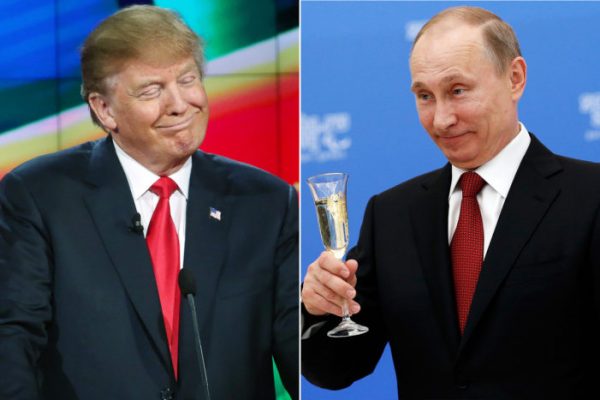
“If the US administration finds it possible, we are ready to provide a recording of the conversation between Lavrov and Trump to the US Congress and Senate,” Mr Putin said during a press conference.
He later clarified that he could provide a transcript, not a recording.
Mr Putin also described US politicians whipping up “anti-Russian sentiment” as either “stupid” or “dangerous”.
The comments come after potentially explosive reports on Tuesday night that Donald Trump asked James Comey, the former FBI director, to end an investigation into Michael Flynn’s links to Russia.
“I hope you can let this go,” Mr Trump reportedly told Mr Comey, the day after Mr Flynn, the former national security adviser, had resigned over his undeclared contacts with Moscow.
The New York Times cited a memo that Mr Comey wrote shortly after the meeting with the US president in early February. Mr Trump fired Mr Comey, who was leading the investigation into links between the Trump campaign and Russia, last week.
If confirmed, it would be evidence that the US president had directly tried to influence the FBI investigation.
Israel downplays damage
Israeli officials are seeking to downplay any damage caused by President Trump’s disclosure of classified information to senior Russian officials that was reportedly provided by Israel, and lauded the robust security cooperation with the United States just days before the president is due to arrive for a state visit.
Despite fears that the leak could endanger a valuable Israeli intelligence asset within the Islamic State group, officials stressed that nothing would change as a result of the extraordinary breach.
“The security relationship between Israel and our great ally the United States is deep, meaningful and unprecedented in its scope and contribution to our strength,” Defense Minister Avigdor Lieberman tweeted. “That is how it has been and that is how it will continue to be.”
The White House officials barred United States reporters from witnessing Trump’s meeting with the top Russian officials in the Oval Office,but the Russians, who have a largely state-run media, brought their own press contingent in the form of an official photographer. They quickly filled the vacuum with their own pictures of the meeting with Mr. Trump, Sergey V. Lavrov, the Russian foreign minister, and Sergey I. Kislyak, Moscow’s ambassador to the United States.
Within minutes of the meeting, the Russian Foreign Ministry had posted photographs on Twitter of Mr. Trump and Mr. Lavrov smiling and shaking hands. The Russian embassy posted images of the president grinning and gripping hands with the ambassador. Tass, Russia’s official news agency, released more photographs of the three men laughing together in the Oval Office.
The White House released nothing.
The result was a public relations coup for Russia and Mr. Lavrov in particular, who not only received a collegial Oval Office welcome from the president, but the photographic evidence to prove it. By contrast, when Secretary of State Rex W. Tillerson traveled to Moscow last month, President Vladimir V. Putin of Russia kept him waiting for hours before granting him an audience at the Kremlin. Then, too, Mr. Tillerson left his American press contingent behind.
The Spy’s the Limit
“It’s a security breach for sure, because they should know exactly who’s in the White House,” says Jill Johnston, president of KJB Security Products, a security and surveillance device wholesaler said about the presence of the Russian photographer who was reportedly also a journalist “He could have recorded everything that went on there. He could have definitely left something behind.”
Recording the conversation in the moment wouldn’t have posed much of a challenge; any smartphone or voice recorder could do that. No fancy spy stuff needed. For a more sophisticated takeaway, he could have also hidden a portable signal sensor inside his camera to track nearby radio frequency activity, mapping the wireless devices and over-the-air communications in that part of the White House. Collecting this data could theoretically open the door for future espionage operations by showing what mobile devices were in use in the area, what frequencies they communicated on, whether there were any wireless networks available, and even where fiber optic and ethernet cables were in the walls.
Planting a listening devices would have been trickier, but far from impossible. Some audio bugs are as small as a key or a tube of chapstick. Slightly larger models like GSM bugs use cell network connectivity, and can capture audio and video streams. The photographer could have even set up a laser tap that bounces a laser beam off of window glass to capture sound waves in a room.
Planting a listening devices would have been trickier, but far from impossible. Some audio bugs are as small as a key or a tube of chapstick. Slightly larger models like GSM bugs use cell network connectivity, and can capture audio and video streams. The photographer could have even set up a laser tap that bounces a laser beam off of window glass to capture sound waves in a room.
“He absolutely could have bugged the Oval Office,” says David Kennedy, who worked in US intelligence and is now the CEO of TrustedSec, which does penetration testing, including physical security checks like bug sweeps. “You could tuck anything into [camera] equipment and make it very difficult to detect.”
A Trump administration official told the Washington Post on Wednesday that the photographer and his equipment were both screened before they went into the White House, the same way a member of the US media would be screened.
Telegraph /Wired
Leave a Reply
You must be logged in to post a comment.